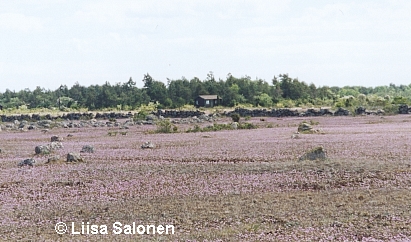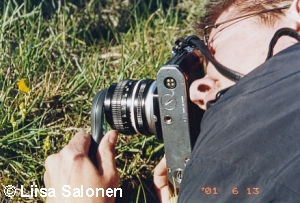
 Our
trip to Öland in 11.-14. 6. 2001
Our
trip to Öland in 11.-14. 6. 2001
 Before
going to Öland, I had myself only seen wild orchids in Finland. We
went there in summer 2001. Here is the desccription of our journey (similar
text will probably also soon appear in Hardy Orchid Sociey Newsletter
Before
going to Öland, I had myself only seen wild orchids in Finland. We
went there in summer 2001. Here is the desccription of our journey (similar
text will probably also soon appear in Hardy Orchid Sociey Newsletter
After a long time of preparing, we were finally on our way to Öland. We left Finland on 10. June. Our ferry landed to Stockholm in the next morning and with the car of one of the travellers we reached Öland in the afternoon. The trip through eastern Sweden gave as a good picture of what we would see. Althought we didn´t notice any orchids on road, there was tens of other plants which are very rare in Finland. We had to stop the car time-by-time to photo these flowers, and even when we did lot of that, we had plenty of time in the same evening to go and find some orchids. The ride from Stocholm to city of Kalmar took about 6 hours with the stops, if I remember right. From Kalmar there goes a pridge to Öland, to a place called Färjestaden. We got a small cottage from Färjestaden and after eating, it was time to go to field. We did´t got far away from the cottage in Hagapark when we saw the first orchids. They were Dactylorhiza sambucina, which weren´t in flower anymore. Other orchids were also present in this angient graveyard of the Vikings (Epipactis helleborine, Platanthera spp.) but none had flowers. Therefore we were soon able to proseed to the place we were actually looking for.
In the map of Öland ("Karta över Öland") there is a text "Kråketorp" near to the center of Färjestaden. Under that text, there is a small parking place. This place has lots of interesting orchids, I had heard. It was near to our cottage and we decided to see this place first. Right after parking the car, when we were crossing the road, the first orchid appeared: Orchis militaris was in full flower. It is an extremely rare species in Finland, growing in few places only, and despite searching I had never seen it before. In this place there was only few specimens, but later on we saw many more Military Orchids. We had, as we saw, parked at the western side of Stora Alvaret. It is a huge, dry, stony field with lot of lime and even more orchids. It didn´t take too long to find more species, Anacamptis morio (Orchis morio), Neotinea ustulata (Orchis ustulata), Orchis mascula, Dactylorhiza sambucina and lots of closed Platantheras. All of them grew in masses, and this site was one of the best places we visited. A. morio, D. sambucina and O. mascula were mostly staring to wither. Only a single flowering D. sambucina (or Adam and Eve as the Swedish call it) was present. This one had red flowers. I haven´t seen good plants of yellow Elder-flower Orchids in years now.
 At
the same day we also went to Södra Utmossen, which was a marsh nearby.
We did see many orchids (Orchis militaris, some of which were enormous,
Platanthera spp., Netinea ustulata, Dactylorhiza incarnata,
Orchis mascula) but this was not particularly interesting place.
I had heard that there would be some Gymnadenia odoratissima in
here, but at least we couldn´t find any. This place was the only
one I remember having grazing horses, elsewhere (almost everywhere in the
island...) cows did this job. In some places lots of orchids were eaten
or cutted off by cattle.
At
the same day we also went to Södra Utmossen, which was a marsh nearby.
We did see many orchids (Orchis militaris, some of which were enormous,
Platanthera spp., Netinea ustulata, Dactylorhiza incarnata,
Orchis mascula) but this was not particularly interesting place.
I had heard that there would be some Gymnadenia odoratissima in
here, but at least we couldn´t find any. This place was the only
one I remember having grazing horses, elsewhere (almost everywhere in the
island...) cows did this job. In some places lots of orchids were eaten
or cutted off by cattle.
At the next day we drove further north, first to Halltorps Hage, a grove of very old oaks and other interesting trees. At first we only found few orchids. Dactylorhiza fuchsii, Neottia nidus-avis and Listera ovata were new species for this trip. We tried to search for Cypripedium calceolus which should have grown here, but with no success. We got bored with this dark wood guite soon. Fortunately we sow from a guide-map that there was a meadow nearby. We couldn´t stop ourselves from going there. It was a beautyful place, protected and well-cared meadow with nice Hazel-nut-trees, climping Ivys and other plants which are exotic in the eyes of a Finn. Lots of orchids was in flower: Dactylorhiza fuchsii in great amounts, Orchis mascula (including one with greenish white flowers), Neotinea ustulata, Neottia nidus-avis, Listera ovata, Orchis militaris, Platanthera bifolia (the only flowering Butterfly Orchid we saw, this was probably ssp. latiflora). Epipactis helleborine didn´t flower. We also found two new species, Ophrys insectifera and Cypripedium calceolus in a beautyful flower. Halltorps Hage was, with the part of Alvar in Kråketorp, the best place in Öland we found.
Next stop was Knisa Mosse, a marsh which has lots of orchids, including Dactylorhiza sphagnicola which we didn´t find. Instead, there was lots of Military Orchids, some of them had a wonderful pale pink colour. The largest Dactylorhiza incarnatas we saw also grow here. Gymnadenia conopsea was a new species, but it didn´t flower yet. Also lots of young shoots of Epipactis palustris was seen, but they won´t flower before July. There also grows some Pinguigula vulgaris (beautyful carnivorous plants, not an orchid).
Next destination was an airport in the northern Öland. We had heard that there would be some Cephalanthera longifolias in there. But for our wonderful suprice, we soon noticed these white flowers growing along the road. They were magnificant plants, and as there was lots of them in whole northern Öland, they are a very good reason for everyone to wisit the island. Ther is also a photo of a single shoot and one small group of plants. It is a pitty though, that we didn´t go to the airport after all. Later on I found out that there also grows lots of Spiranthes spiralis (not in flower at that time of the year, of course). I have not seen this plant yet because of this mistake.
Anacamptis pyramidalis should have grown in one field at the north, but we didn´t find it. Instead there was some flowering Gymnadenia conopsea over there, but as many much more interesting sites can be easily found, I don´t try to explain that where this place is. In the same evening we also went to see the famous Echium vulgares at the northern end of the island. They were not in full flower yet. After this and collecting some fossiles from a rocky beach we went back to out cottage to make some food. We only ate our box lunch while on road and therefore we were pleased to have proper food after a long day.
In the third day we first went to Böda Sand (long sandy beach at the north) to find Liparis loeselii from one marsh, but as we didn´t spot it, the place was not that interesting, we only managed to find Dactylorhiza maculata as a new species. It is a common flower in Finland so it wasn´t too fascinating. One plant had peloric flowers. The photo is wors, but thats because we didn´t photo such usual species too much.
 Möckelmossen
in the middle of Stora Alvaret was the second place we went to. It is a
bond surrounded by short, grazed grass. The place seemed perfect for Herminium
monorchis, which we also found even without any search. We were
guite lucky, as we only saw less than ten plants in two groups, each about
two inches high. They smelled good, but as the wind was strong we had to
get close to the flowers to smell them. For myself this was the most important
of all of our findings, because it has extinct from Finland. Soon later
we found our last new species, few Dactylorhiza
cruenta flowered among tens or hundreds of Dactylorhiza incarnatas.
After Möckelmossen we also saw some flowering Adonis
vernalis, not an orchid but one of the goals we had to this trip.
We only had one photo and an fairly inexact words of where the photo was
taken helping us to get to this plant. We didn´t even have to find
the place for too long, and we soon found ourselves looking the same plants
which were in the photo of our book!
Möckelmossen
in the middle of Stora Alvaret was the second place we went to. It is a
bond surrounded by short, grazed grass. The place seemed perfect for Herminium
monorchis, which we also found even without any search. We were
guite lucky, as we only saw less than ten plants in two groups, each about
two inches high. They smelled good, but as the wind was strong we had to
get close to the flowers to smell them. For myself this was the most important
of all of our findings, because it has extinct from Finland. Soon later
we found our last new species, few Dactylorhiza
cruenta flowered among tens or hundreds of Dactylorhiza incarnatas.
After Möckelmossen we also saw some flowering Adonis
vernalis, not an orchid but one of the goals we had to this trip.
We only had one photo and an fairly inexact words of where the photo was
taken helping us to get to this plant. We didn´t even have to find
the place for too long, and we soon found ourselves looking the same plants
which were in the photo of our book!
These approximately 20 species may not feel as any magnificent number, but knowing that we were only three days in the island might make our trip to feel more wonderful. Lots of thanks to all of you arounf Europe who helped us to get all the information we needed! In our eyes Öland was a perfect world. Orchids were everywhere and most of the species also in great numbers. Of course, Gotland has many species which don´t grow in Öland, but I think it is well worth to consider Öland as a second option when thinking of an orchid-trip to Sweden.
The missing or great rarity of some of the most common Finnish orchids
was suprising. Listera cordata, Corallorhiza trifida and
Dactylorhiza maculata are such plants. I would have loved to see
also Anacamptis pyramidalis, Liparis loeselii, Dactylorhiza
sphagnicola and the flowering of all those Platantheras would
have been a wonderful sight (and a joy for nose). Fortunately we had such
a good year for Platanthera bifolias here in Finland!